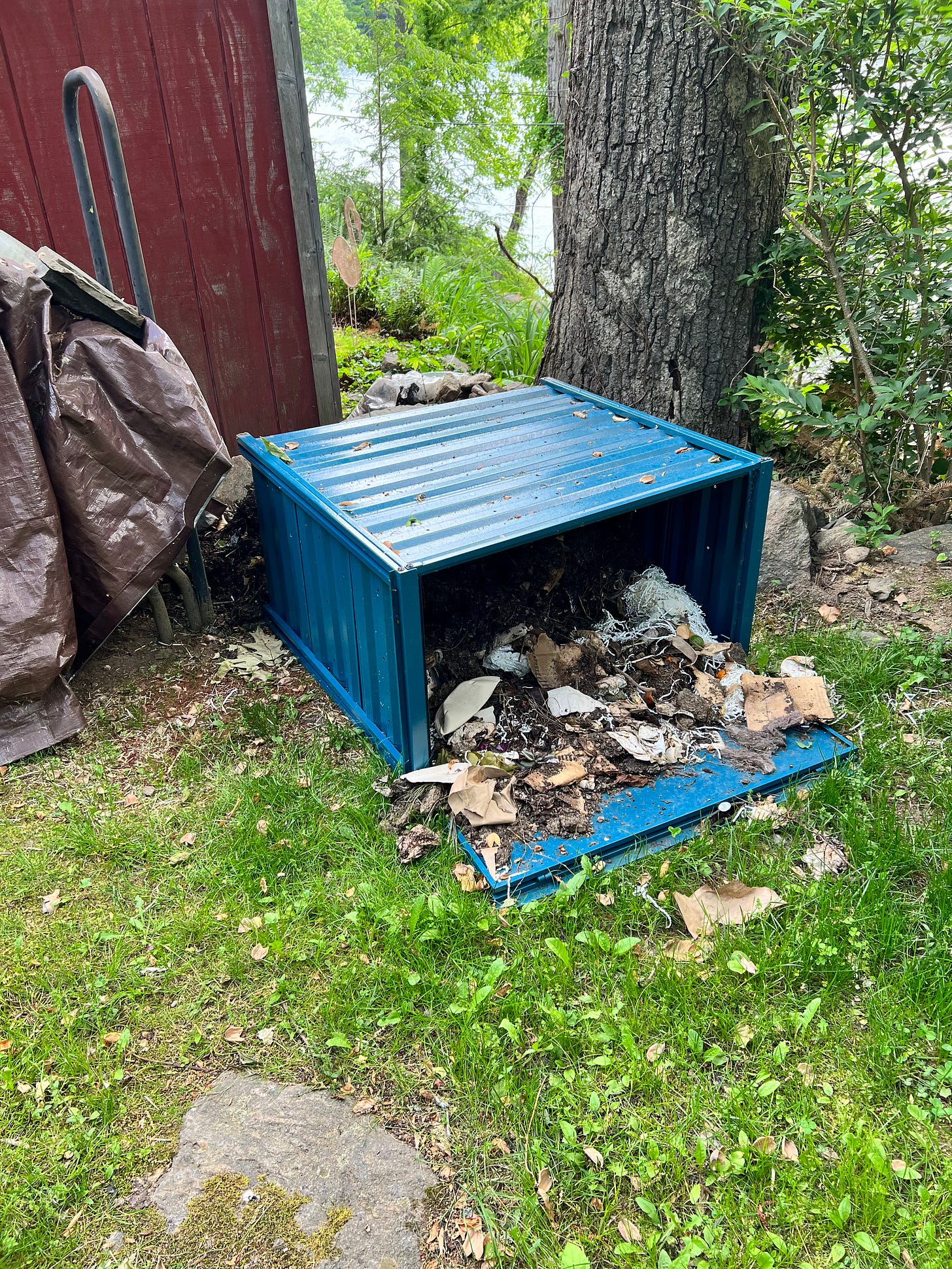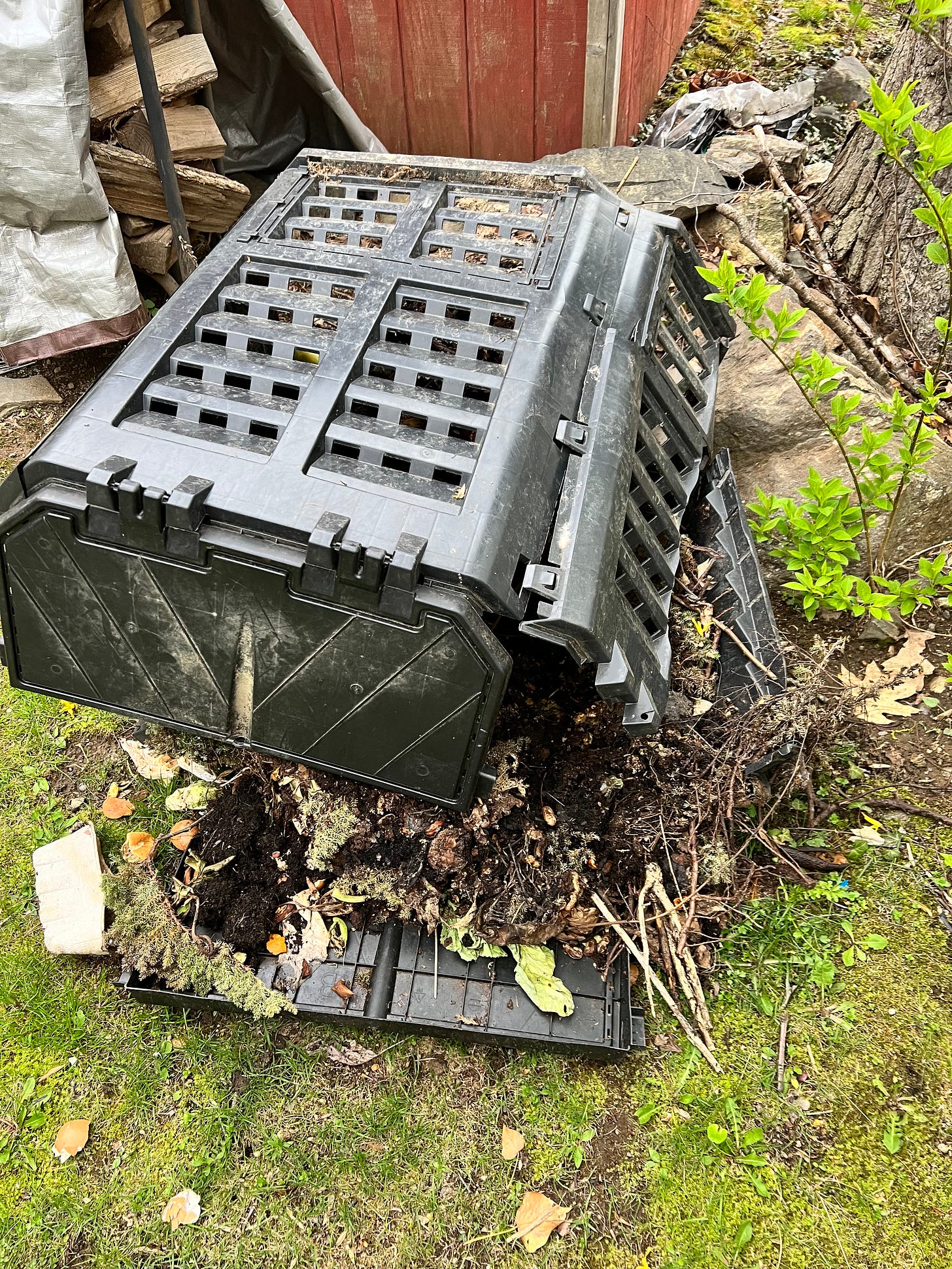How to keep a bear out of your compost
Tackling my most popular (and difficult) reader question.
I have a friend who cannot keep a particular bear out of his compost. Once a week, he sends me texts with a photo: “Bear’s back.” “The bear again.” and “He just picked the whole thing up and took it.” He’s tried everything, he says. For example, he’s tried one type of compost container and then another. Those are about the sum total of things he has tried. The bear keeps getting in, though, and appears to be getting braver. How can he keep the bear out? he wants to know. He’s desperate.
Well, first the bad news.
If a bear decides he wants into your compost, there is simply no way—ever—to keep him out. There’s a property in upstate New York where I used to spend a lot of time and I remember the owner once encased the garbage bins in heavy metal sheeting, aiming to keep bears out. One day later, we woke up to find the top of the enclosure peeled back like a tin can and all the garbage everywhere. Bear did not care.
In general, if your strategy for bears involves challenging their ability to break into something, you will probably lose. Instead, you should aim to build a pile that simply won’t attract their interest in the first place. Impossible, you say? I was once like you. When people asked me how to “bear-proof” their compost, I just laughed. “No such thing,” I said. But after consulting with the Community Composter Coalition on this question, I came away with something unexpected—hope.
Turns out, there’s lots you can do. And most of it’s pretty simple.
Take time to prepare your food scraps
You want to minimize the time that food scraps are sitting around in your pile, so anything you can do to expedite decomposition helps. On that note, do not throw whole food items in there. Chop and shred things into the tiniest possible pieces, first. Stuff that’s already small? Cut it a little smaller. As Lisa from Juneau Composts wisely advises: “Preventing bear encounters is 100% easier than dealing with problem bears, so take the time!”
Build a biocap
This was universal. Every single composter I talked to who lives in bear country keeps their compost covered in a thick “cap” of organic, non-edible materials, like sawdust, straw, or wood chips. Ruthie, from Manitou, uses a 6-10” inch biofilter cap of mulch, dirt and wood ash to “keep bears from sniffing things out.” Sue W., already cited above, employs a similar strategy: “I cover [my] pile with a thick layer—6-8” of loose straw, and the pile is not in direct sunlight.”
Restrict your inputs
If you live in bear country, there are simply some food types that you want to avoid composting altogether. Take the word of Sue W., a seasoned composter and lifelong resident of Colorado: “I have composted at home high in the Rocky Mountains for nearly 34 years and managed to keep bears out of the pile by restricting all animal products, dairy, bones, skins, and oils and fats in large proportions.”
Put bad smells to use
The odor of food may attract a bear, but there are other odors that can deter. The Vermont Fish & Wildlife department recommend leaving an ammonia-soaked rag in a bucket near your compost. Refresh every 2-3 weeks.
Bury your food in the pile
Perhaps this is redundant with the above “biocap” recommendation, but it’s worth reiterating loudly: do not leave food scraps exposed on the top of your pile. Tuck them under. Keep them covered.
Some resources I perused recommended compost tumblers and other types of structures as being “bear proof.”
This is a lie.
No structure is bear proof. If a bear can’t outright destroy a thing, he will—at minimum—try, which means you still have to deal with him on your property. However, if you’ve attempted everything on the above list and you’ve still got an issue, you might be interested in the final frontier of bear management: the electric fence. This one comes care of Lisa, proprietor of Juneau Composts and inevitable expert in bears:
“[My] fence is 5 strands of polywire hooked up to a 1 joule energizer that is powered by a DC battery. Three ground rods in parallel sunk 5' deep in a very wet spot. I run the system on alternating strands (positive, negative, positive, negative, positive, then the soil/ground, which is negative). Once it starts snowing I switch all wires to positive but then disconnect each bottom strand as the snow builds up. I can get a reading of 16V off the fence even though it's a 12V battery. Don't ask me how that works. lol. When I first set the fence up I was only ever getting 6-7 and was told that was good, but it is not enough to deter a bear. I see bear tracks at the yard pretty regularly, but the fence keeps them out. It needs a walk around daily to make sure nothing is grounding out and I make sure it's 10V+ at all times. Bears can climb any fence you make unless it's electric. It really is the only way to keep them out.”
So what ultimately came of with my friend, you ask?
Somebody (not me) told him that peeing on your pile is a bear deterrent, so now he just texts me whenever he does that. Great. But apparently, the bear has not been back.
Love,
Cass





If you use enough bungee cords and ratchet straps and strap it to a tree.. it's worked for us. Sometimes he can maneuver a paw in to get a tiny bite but that's it.
Love that you’ve been writing this blog. Recently started one called 13 Tons of Love about compost, mothers, art (I’m a photographer) and life. I’d love to hear what you think!